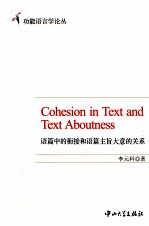
- 作 者:李元科著
- 出 版 社:广州:中山大学出版社
- 出版年份:2012
- ISBN:7306042538
- 标注页数:258 页
- PDF页数:272 页
请阅读订购服务说明与试读!
订购服务说明
1、本站所有的书默认都是PDF格式,该格式图书只能阅读和打印,不能再次编辑。
2、除分上下册或者多册的情况下,一般PDF页数一定要大于标注页数才建议下单购买。【本资源272 ≥258页】
图书下载及付费说明
1、所有的电子图书为PDF格式,支持电脑、手机、平板等各类电子设备阅读;可以任意拷贝文件到不同的阅读设备里进行阅读。
2、电子图书在提交订单后一般半小时内处理完成,最晚48小时内处理完成。(非工作日购买会延迟)
3、所有的电子图书都是原书直接扫描方式制作而成。
Chapter 1 Introduction 1
1.1 A short review of studies on cohesion and of aspects of cohesion that have not been explored sufficiently 1
1.2 The aim of my present study 3
1.3 The organization of the book 4
Chapter 2 Literature Background 7
2.1 Introduction 7
2.2 Hasan(1984)and Halliday and Hasan(1985) 7
2.3 The limitations of Hasan's method and improvements 20
2.4 Parsons(1991a,1991b) 36
2.5 Hoey(1991) 41
2.6 Scott's Key Words tool 48
2.7 Hoey's(2001) Textual Interaction 51
2.8 Mann and Thompson's(1988a,1988b)Rhetorical Structure Theory 56
2.9 Conclusions 62
Chapter 3 Research Question 1 and the Method 64
3.1 Introduction 64
3.2 Research question 1 and the data 64
3.3 The method used to explore research question 1 66
3.3.1 Classifying processes in a text into chains according to the commonality of meanings they express 67
3.3.2 Unpacking in text nominalizations that contain nominalised processes included in chains 85
3.3.3 Identifying recurrent nuclei in text 120
3.3.4 Ranking the recurrent nuclei in text in descending order of frequency 127
3.3.5 Classifying processes in summaries into chains according to the commonality of meanings they express 128
3.3.6 Unpacking in summaries nominalizations that contain nominalised processes included in chains 134
3.3.7 Identifying recurrent nuclei in summaries 141
3.3.8 Comparing the results in A4 with that in B3 to identify the recurrent nuclei in text that are repeated in two or more summaries of the text 142
Chapter 4 Findings with Regard to Research Question 1 143
4.1 Introduction 143
4.2 The results with regard to research question 1 143
4.3 The characteristics of the recurrent nuclei in texts that are important to the texts' meanings 151
4.3.1 Category 1 151
4.3.2 Categories 1(c),2 and 3(b) 159
4.3.3 Subcategory 3(a) 164
4.3.4 The probability of presence in the leads of the recurrent nuclei that are important to texts' meanings 167
4.3.5 Category 4 168
4.4 Conclusions 173
Chapter 5 Research Question 2 and Findings 177
5.1 Introduction 177
5.2 The definitions of type A and type B nuclei 177
5.3 Research question 2 and the method of exploring the question 179
5.4 The results with regard to research question 2 191
5.5 Examining the‘maverick' cases 196
5.5.1 The seven initial occurrences of type A material nuclei that express causes 196
5.5.2 The four initial occurrences of type A material nuclei that are part of the content of saying of verbal nuclei 203
5.5.3(a) The initial occurrences of two type A material nuclei that contextualize 208
5.5.3(b) The six initial occurrences of type B material nuclei that also contextualize 211
5.5.4 Proposition splitting 217
5.5.5 Inference 222
5.5.6 Proposition integration 227
5.5.7 Reduction 228
5.5.8 The remaining and final example 231
5.6 Conclusions 232
Chapter 6 Conclusions 236
6.1 Introduction 236
6.2 Areas of innovation and contribution of my present study 236
6.3 Patterns of lexis in a text and the meaning of the text 237
6.4 Information distribution in the leads 239
6.5 The strategies that summary writers often use to write summaries for hard news texts 241
6.6 Conjunctive relations and the meaning of a text 242
6.7 Future research avenues 246
Appendix A 250
Appendix B 252
References 253
